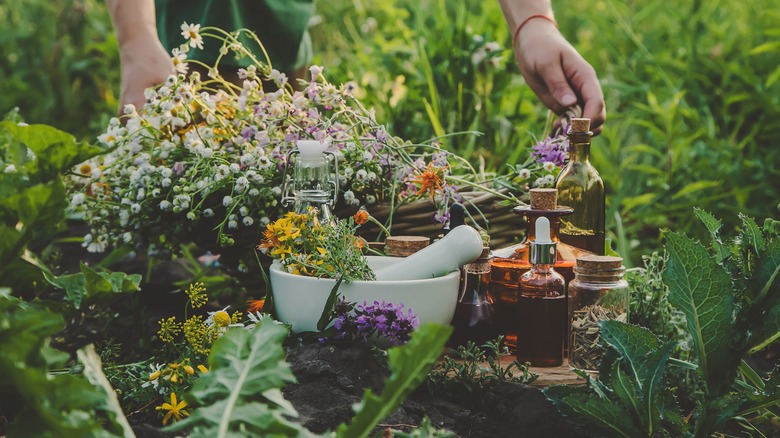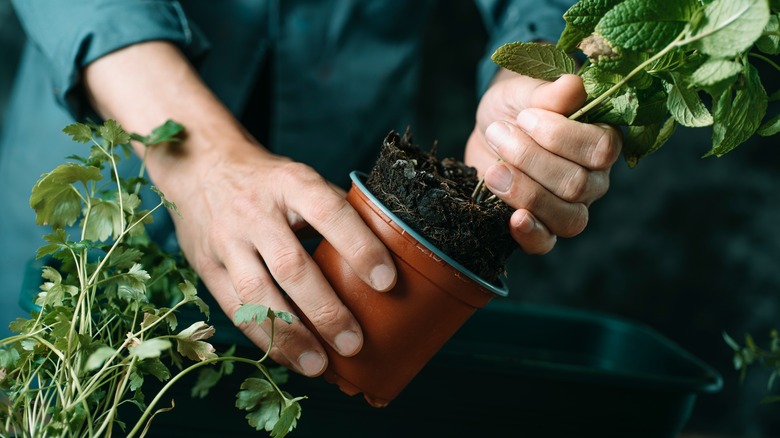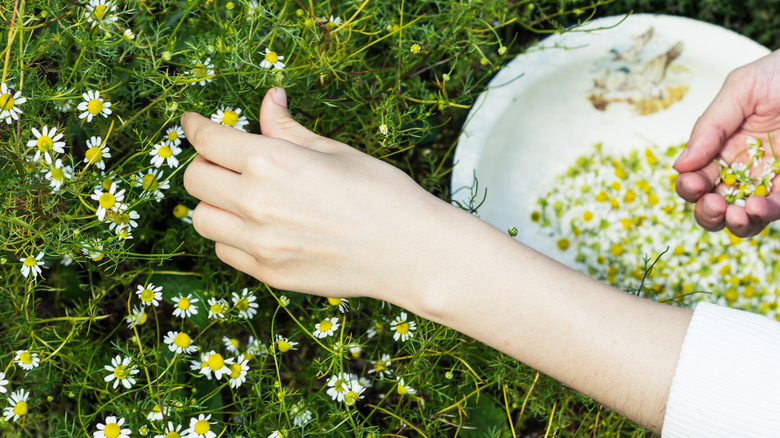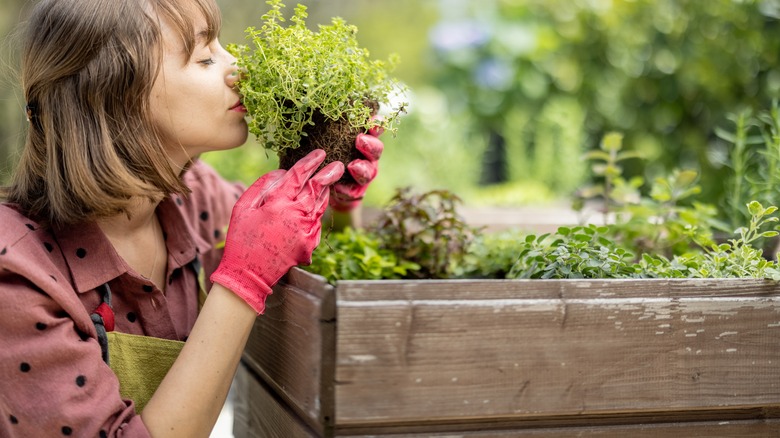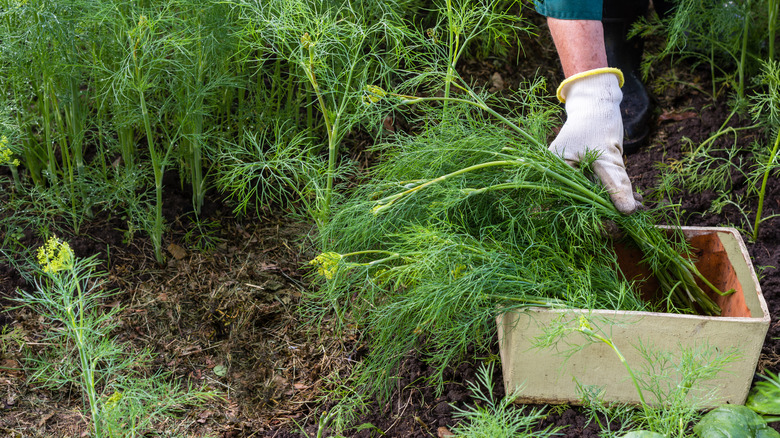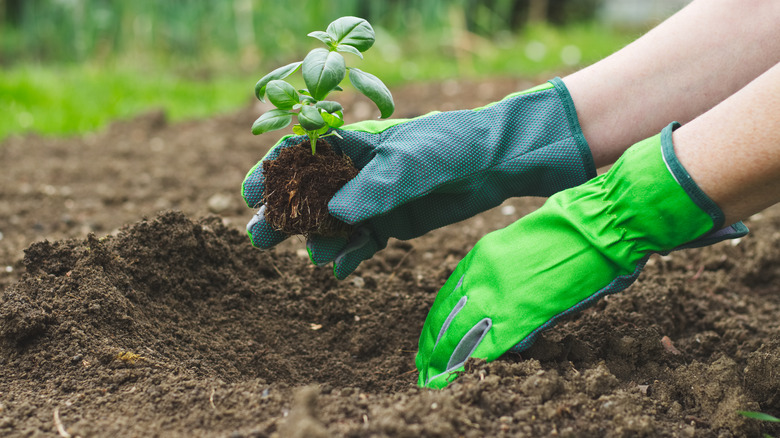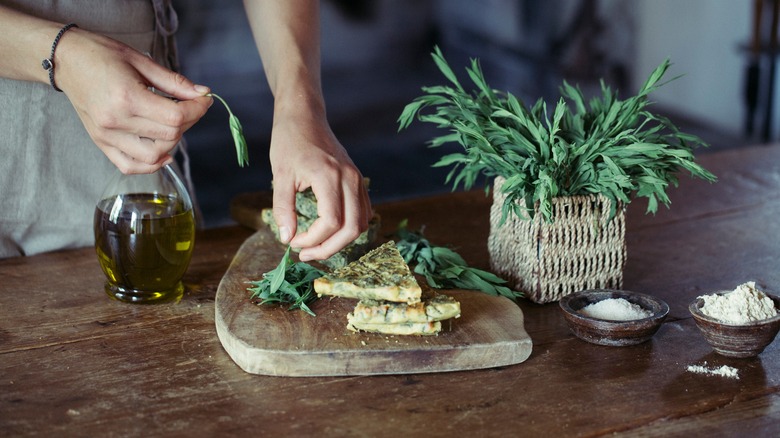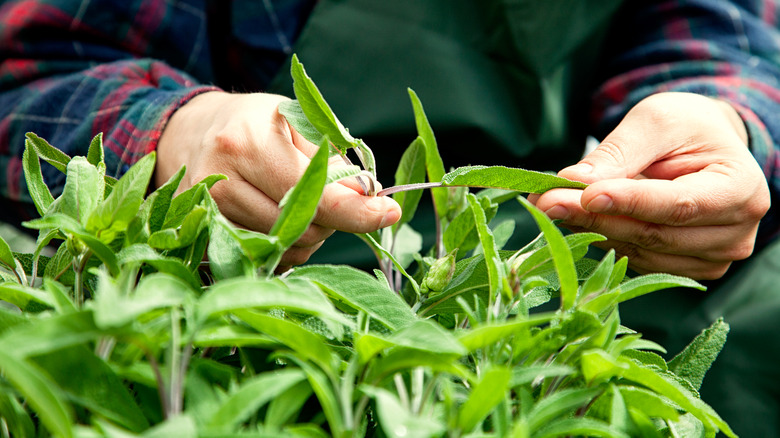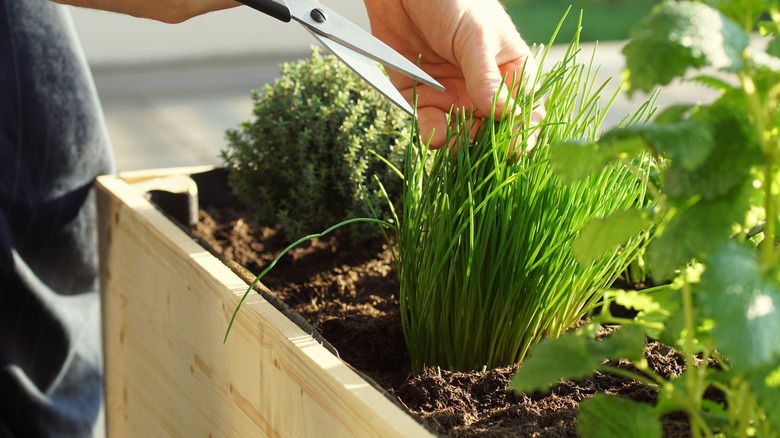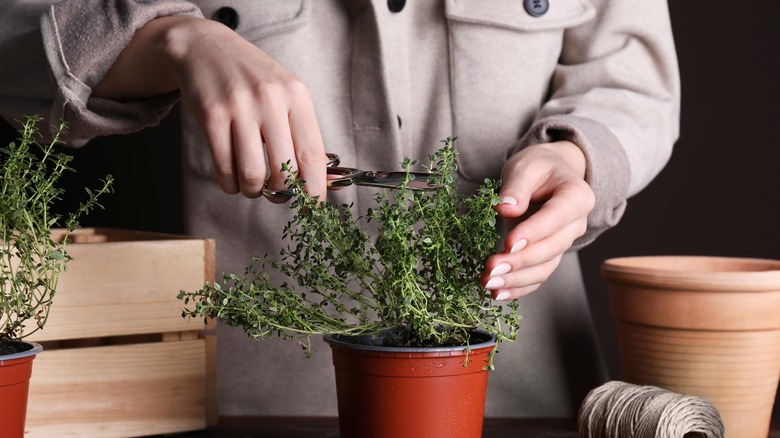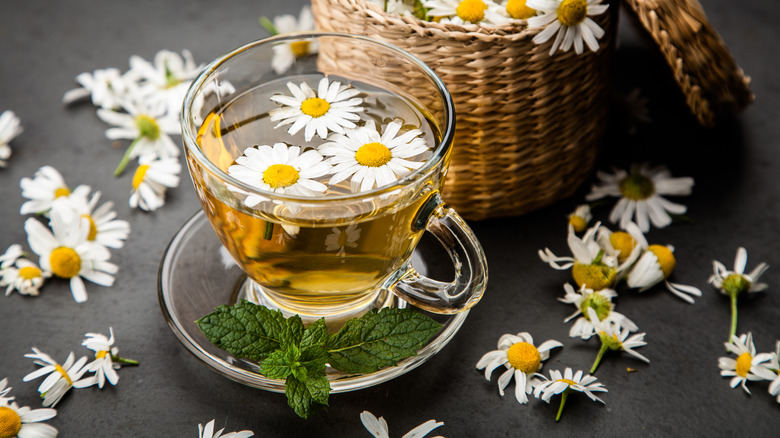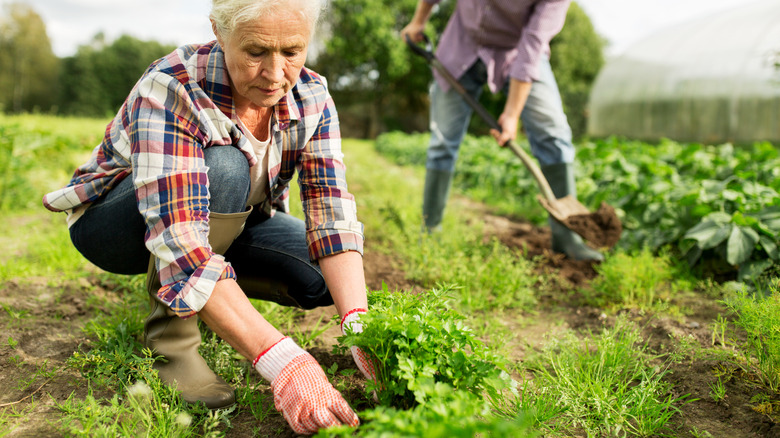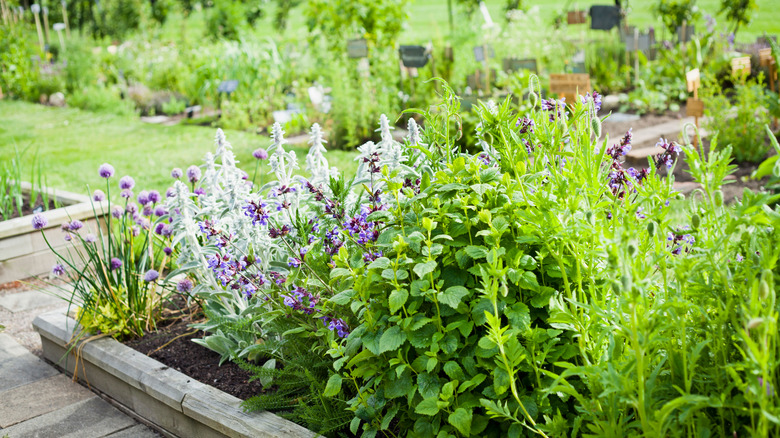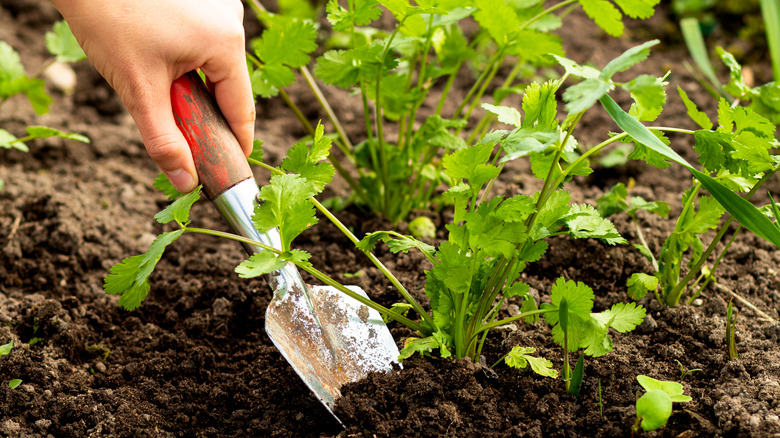Herbs You'll Want To Avoid Growing Too Close Together In The Garden
An herb garden might be a good way to relax while you work in your yard. You can add these little plants to your yard to make it look nicer and make your food taste better. However, you need to know which herbs may stop each other from growing, because not all of them get along. Putting certain herbs together can reduce their qualities, making them less flavorful in your dishes. Also, the struggle these plants have to go through to get the water and nutrients they need to thrive might mean you have to spend more time babying them to get strong growth, which takes your time away from other projects.
To ensure you get strong plants, you have to have a strategy in place during planting. We'll help you figure out herb pairings to avoid and how to plant them for strong growth, ensuring each plant thrives and gives you fragrant, productive herbs.
Mint and parsley outcompete one another
Mint and parsley are popular herbs, but you want to space them out. Due to their hugely different environmental needs and growth habits, which can make them compete as they grow. Mint is a very aggressive herb that spreads quickly using underground runners. If you don't contain and keep it in check, it can overtake nearby plants, including parsley, and ensure it doesn't get the water, nutrients, and space it needs to grow. Mint also likes light shade with moist soil; parsley needs well-drained soil with steady sun. Mint's invasive growth also makes harvesting parsley challenging because it can develop among the leaves.
To address this, plant mint in its own container to help control the spread and ensure it doesn't compete with surrounding herbs. If you must put companion plants into the same pot, include other quick-growing herbs that love moisture, like lemon balm. Plant mint on the edge of your garden and have it spread away from anything else. Parsley grows well with tomatoes, which can shade it and help reduce weed growth. Planting parsley with roses or asparagus works because the scent helps repel pests that plague these plants.
Chamomile and fennel have conflicting root systems
Chamomile and fennel are both pleasant to have in your herb garden, even if chamomile isn't the ideal house plant for indoor setups. However, both plants need different nutrients and have conflicting root systems, which means they won't grow well together. Fennel secretes substances that can stunt any surrounding plants. Chamomile is less aggressive but won't grow as well when you put it near this herb. Fennel attracts insects that eat chamomile and other tender herbs, causing your chamomile to be weak and produce fewer flowers. They both like the same sun exposure, but fennel's dominant nature means they're not good companion plants.
Chamomile does well if you put it with cucumber, sage, and marigolds because these plants help deter common pests that can damage the herb. Fennel grows well with dill because they like the same growing conditions but won't compete. To avoid problems, don't put fennel by vegetables, most herbs, or flowers. You create a balanced garden where each plant can grow strong by pairing these two herbs with the best companions.
Rosemary and basil have different water needs
Rosemary and basil are extremely popular in herb gardens, but planting them close can slow their growth. This is mainly due to the water they need, with rosemary needing well-drained and dry soil that mimics its Mediterranean roots. It loves controlled moisture environments and struggles if the soil is too wet. Basil needs more water to keep the leaves healthy and lush, and it prefers fertile, moist soil. When you plant them close, meeting their differing water needs is challenging. Rosemary is also a strong, woody shrub that can get bushy enough to overshadow basil. It'll block a lot of sunlight, stunting your basil's development and growth, and can overpower basil's lighter scent.
Pair rosemary with drought-resistant plants and herbs like thyme, sage, or lavender. They all have similar soil and water needs, which minimizes competition while encouraging healthier growth. Basil does well planted next to peppers and tomatoes. When you plant them together, basil wards off harmful insects that eat pepper or tomato plants. In return, the vegetables shade the basil and keep the soil moist. You can also plant basil with spinach, lettuce, or cilantro because they all like more water.
Dill and cilantro have conflicting growth cycles
You may want to think twice before planting dill in the ground or a pot next to cilantro because of space requirements and conflicting growth cycles. Dill grows faster and taller than cilantro, and it will cast shade over it to stunt its growth. Dill and cilantro release allelopathic chemicals to stunt plants around them. Growing them side-by-side makes their root systems to clash, reducing how much you can use. Cilantro also needs a more stable environment, while dill survives fluctuations. They like different temperatures, and trying to make both happy in a small space can stress the herbs and make them prone to pests or disease issues.
Dill's slim and tall structure lets you plant it with lettuce and onions, helping to deter pests without the plants competing for nutrients. Dill also grows well with corn and cucumbers, and it'll attract bugs that keep pests from eating the cucumbers. Corn is something for dill to lean on. Cilantro grows well with carrots and spinach because spinach likes the same amount of water and partial shade, which keeps the soil cool. Carrots loosen the soil around the cilantro, allowing its roots to grow better.
Basil and sage will impede each other's development
Basil and sage are two popular plants that make bad companions. They have varying growth needs that can make them get in each other's way. Basil is a tender herb that likes moist, rich soil with a lot of sunlight exposure. A consistent watering schedule is needed to keep the leaves healthy, while sage is hardy and needs well-drained, slightly sandy soil with less water. Sage's need for drier soil and its stronger growth creates an environment that stresses your basil plants because they'll compete. Sage's strong growth habit and root system can overpower your basil, stunting the growth. Watering enough to encourage healthy basil plants can drown sage roots, too.
To get healthy sage and basil, pair them with plants that have similar water and sunlight needs. For basil, plant it alongside tomatoes because they both like moist soil, and basil will ward away pests from your tomato plants. Basil also grows well with peppers, and they'll enjoy the higher humidity watering brings. Sage works well with thyme and rosemary because they all have close light, water, and soil preferences. Planting them close will create a microenvironment where their scents repel pests. Sage also grows with cabbage or carrots because they don't compete for water.
Tarragon and parsley have different growth needs
Although parsley and tarragon are popular, they have different growing needs that make them bad companion plants. Tarragon is a perennial that needs well-drained soil with full sun in a dry environment. It grows deep roots that let it get water from deeper in the soil to help it survive drought. Parsley is a biennial that needs moist, rich soil with more water to grow, and it needs shade to avoid sun scorching. Their varying water needs make it hard to plant them together, leading to water stress for both herbs. Tarragon has a slight allelopathic effect, which can stunt parsley's growth when the plants are young, slowing down the germination rate.
To avoid this, plant tarragon with plants that have similar water and light needs. Good companion plants include rosemary and lavender, as they both need full sun and drier soil. These plants won't compete for water or nutrients, making them easier to manage. Parsley works well with asparagus and tomatoes, and the tomatoes will offer shade to help reduce water loss from the soil. Asparagus loves wetter conditions, too, benefitting from parsley's ability to repel pests.
Sage and fennel have different root systems
Fennel and sage are popular aromatic herbs that work in a huge range of dishes, but you want to space them out. Their root systems have different needs, and they have allelopathic properties. Sage grows a shallow root system, and it loves dry to moderately moist soil with less frequent watering sessions. It grows in full sun with well-drained soil. Fennel has a deeper root system that lets it pull moisture from deeper in the soil, and it likes richer planting mediums. The different watering needs can make the herbs compete, leading to stress. Fennel is also very allelopathic for most other plants, so it can stunt sage's growth by releasing chemical inhibitors.
Sage grows well with rosemary and thyme because they like the same amounts of water and sun and grow nicely with carrots or cabbage, which repels pests that may eat them. If you want to plant it with other herbs, sage and oregano are great companion plants. Fennel should be away from other herbs and vegetables for the most part, but dill can survive as a companion plant. Putting fennel and dill together attracts bees and ladybugs to help with pest control and pollination. Consider putting fennel on your garden's edges or in an individual container to prevent the roots from pushing the chemicals into your garden beds.
Chives and garlic attract common pests
Chives and garlic fall into the Allium family, but you want to separate them. They have similar nutrient needs and attract common pests, so you'll have a problem keeping them healthy. They need higher nitrogen levels to develop their flavors and promote vigorous growth, competing for the same nutrients. This will result in slower or stunted growth. They both attract pests like thrips or onion flies, and you can get a more severe infestation when you group them. They're also prone to problems with the same diseases, which can transfer to surrounding plants.
When you plan your garden, avoid planting garlic and chives if your pets can get to it. However, if they're safe, pair your chives with carrots to ensure chives' natural sulfur compounds help repel carrot root flies and prevent fungal diseases. Carrots will reduce weed competition for chives, too. Garlic works well with peppers or tomatoes because the smell deters pests. Garlic also has anti-microbial properties that can lower the chances of having issues with soil-borne diseases.
Thyme and cilantro have incompatible growing conditions
Thyme and cilantro offer distinct flavors to your food but make poor garden neighbors because they need different growing conditions. Thyme is drought-tolerant and loves full sun with a well-drained growing medium. It doesn't need a lot of water once it is established, and it'll get stressed if you water it too much. Cilantro needs cooler growing space with richer, loamy soil that drains well and more water. Planting them side-by-side causes water management problems. The amount of water you have to give cilantro makes thyme sit in damp soil, making it vulnerable to root rot. Thyme also has a slow growth rate compared to how cilantro spreads, and it can overtake the thyme and weaken it.
To optimize both herbs, pair thyme with lavender or rosemary because all three herbs are similar in growing conditions, reducing how much they compete as they grow. Thyme also does well next to strawberries or cabbage. Cilantro works better with tomatoes or spinach. The spinach will get shade from cilantro to keep the soil moist, and tomatoes benefit because cilantro can deter pests. Put a few inches of space between each plant to give the root systems space to spread.
Mint and chamomile have different environmental needs
Mint and chamomile have a long history of medicinal use and a reputation for strong smells, but they're bad companion plants because of their growth habits and needs. Mint is invasive, using underground runners to spread to take over your garden. It can choke out nearby plants like chamomile and compete heavily for light, nutrients, and water. Also, mint likes moist soil and can survive in partial shade, while chamomile needs well-drained soil with more sun. Keeping the soil damp enough for mint to thrive is too wet for chamomile, leading to fungal diseases.
Cabbage and kale will grow well next to mint because they can handle the same growing conditions and won't get overrun. You should also consider planting mint in a container so you can trim it and control how far it spreads before it takes over. Chamomile grows nicely around cucumbers, marigolds, or sage. They all need the same growing environment, and chamomile's scent may help deter some pests so you're not constantly having to fight new infestations to keep your garden healthy.
Parsley and lemon balm compete with one another
Parsley and lemon balm go with many dishes, but their contrasting growing needs make them poor companions because they'll compete. Parsley must be consistently moist and in loamy, rich soil. It loves cooler temperatures and can benefit from light shade because this keeps the growing medium cooler. Lemon balm, on the other hand, loves well-drained soil and drier conditions. Also, this herb's quick growth and extensive root system can overwhelm parsley, out-competing it for nutrients and water. Lemon balm may attract mites and aphids, and they can infest your parsley and damage it.
For a healthy herb garden, put parsley by your tomatoes or asparagus. These plants can act as natural supports to keep your parsley upright, and the foliage shades the ground to keep it cooler and moist. Parsley also does well with corn because it will give partial shade as it grows. For lemon balm, put it by cauliflower or broccoli because its scent can help repel pests while giving it space to spread without taking over. It's also a good partner for strawberries because it wards off pests and attracts pollinators.
Lavender and mint have very different watering needs
Lavender and mint have strong aromatic qualities, but they have largely different growing requirements that make them poor companion plants. Lavender comes from the rocky Mediterranean region, and it grows best in well-drained, dry soil under full sun. It resists drought and requires very little water once established. On the other hand, mint loves partial shade and moist soil, and it needs consistent moisture levels to keep the foliage healthy. Water competition is the biggest concern if you plant them too close together. Excessive moisture around lavender leads to root rot and fungal diseases. Mint grows quickly and can take over the garden, choking out the lavender.
Lavender grows best with other Mediterranean herbs like thyme, sage, and rosemary because they all love sun exposure and have similar water needs. This reduces competition and encourages healthier growth. It's a good idea to grow mint in a container so you can control how it spreads. However, if you put it in the ground, plant it next to oregano, marigolds, or peas. Mint repels certain pests that may go after these plants, keeping them healthy. Peas improve the soil quality and provide shade to keep the soil moist.
Coriander and rosemary have differing growth needs
Coriander and rosemary are popular culinary herbs, but they require quite different growing conditions. Rosemary flourishes in hot, sunny climates and prefers well-drained, sandy soil, but coriander prefers milder temps and moist, fertile soil with adequate drainage and organic matter. When grown together, rosemary's preferred dry circumstances can stress coriander, leading it to bolt to seed before harvest. In addition, rosemary's strong, woody growth can overshadow smaller coriander plants, limiting their exposure to sunshine.
To ensure that coriander and rosemary grow, combine them with plants that have similar growing needs. Beans and spinach make wonderful partners for coriander because they give shade, chill the soil, and nourish it, all of which promote coriander leaf production. Rosemary pairs well with Mediterranean herbs such as thyme, sage, and lavender, all of which demand full sun and little water. Additionally, rosemary thrives near carrots and cabbage because its pungent aroma naturally repels pests.

